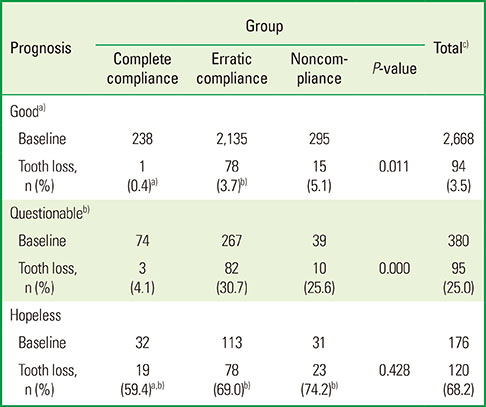1. Hujoel PP, Leroux BG, Selipsky H, White BA. Non-surgical periodontal therapy and tooth loss: a cohort study. J Periodontol. 2000; 71:736–742.

2. Pihlstrom BL, McHugh RB, Oliphant TH, Ortiz-Campos C. Comparison of surgical and nonsurgical treatment of periodontal disease: a review of current studies and additional results after 61/2 years. J Clin Periodontol. 1983; 10:524–541.

3. American Academy of Periodontology. Glossary of periodontal terms. Chicago: American Academy of Periodontology;2001.
4. Sackett DL, Haynes RB. Compliance with therapeutic regimens. Baltimore: Johns Hopkins University Press;1977.
5. Wilson TG Jr, Glover ME, Schoen J, Baus C, Jacobs T. Compliance with maintenance therapy in a private periodontal practice. J Periodontol. 1984; 55:468–473.

6. Mendoza AR, Newcomb GM, Nixon KC. Compliance with supportive periodontal therapy. J Periodontol. 1991; 62:731–736.

7. Demetriou N, Tsami-Pandi A, Parashis A. Compliance with supportive periodontal treatment in private periodontal practice. A 14-year retrospective study. J Periodontol. 1995; 66:145–149.

8. Novaes AB, Novaes AB Jr, Moraes N, Campos GM, Grisi MF. Compliance with supportive periodontal therapy. J Periodontol. 1996; 67:213–216.

9. Park WK, Lee JK, Chang BS, Um HS. A retrospective study on patients' compliance with supportive periodontal therapy. J Korean Acad Periodontol. 2009; 39:59–70.

10. Costa FO, Miranda Cota LO, Pereira Lages EJ, Vilela Camara GC, Cortelli SC, Cortelli JR, et al. Oral impact on daily performance, personality traits, and compliance in periodontal maintenance therapy. J Periodontol. 2011; 82:1146–1154.

11. Miyamoto T, Kumagai T, Jones JA, Van Dyke TE, Nunn ME. Compliance as a prognostic indicator: retrospective study of 505 patients treated and maintained for 15 years. J Periodontol. 2006; 77:223–232.

12. Ramfjord SP, Morrison EC, Burgett FG, Nissle RR, Shick RA, Zann GJ, et al. Oral hygiene and maintenance of periodontal support. J Periodontol. 1982; 53:26–30.

13. Konig J, Plagmann HC, Langenfeld N, Kocher T. Retrospective comparison of clinical variables between compliant and non-compliant patients. J Clin Periodontol. 2001; 28:227–232.

14. Fardal O, Johannessen AC, Linden GJ. Tooth loss during maintenance following periodontal treatment in a periodontal practice in Norway. J Clin Periodontol. 2004; 31:550–555.

15. Checchi L, Montevecchi M, Gatto MR, Trombelli L. Retrospective study of tooth loss in 92 treated periodontal patients. J Clin Periodontol. 2002; 29:651–656.

16. Eickholz P, Kaltschmitt J, Berbig J, Reitmeir P, Pretzl B. Tooth loss after active periodontal therapy. 1: patient-related factors for risk, prognosis, and quality of outcome. J Clin Periodontol. 2008; 35:165–174.

17. Wilson TG Jr, Glover ME, Malik AK, Schoen JA, Dorsett D. Tooth loss in maintenance patients in a private periodontal practice. J Periodontol. 1987; 58:231–235.

18. Shick RA. Maintenance phase of periodontal therapy. J Periodontol. 1981; 52:576–583.

19. Lindhe J, Nyman S. Long-term maintenance of patients treated for advanced periodontal disease. J Clin Periodontol. 1984; 11:504–514.

20. Hirschfeld L, Wasserman B. A long-term survey of tooth loss in 600 treated periodontal patients. J Periodontol. 1978; 49:225–237.

21. Tsami A, Pepelassi E, Kodovazenitis G, Komboli M. Parameters affecting tooth loss during periodontal maintenance in a Greek population. J Am Dent Assoc. 2009; 140:1100–1107.

22. Ng MC, Ong MM, Lim LP, Koh CG, Chan YH. Tooth loss in compliant and non-compliant periodontally treated patients: 7 years after active periodontal therapy. J Clin Periodontol. 2011; 38:499–508.

23. McFall WT Jr. Tooth loss in 100 treated patients with periodontal disease: a long-term study. J Periodontol. 1982; 53:539–549.

24. Goldman MJ, Ross IF, Goteiner D. Effect of periodontal therapy on patients maintained for 15 years or longer: a retrospective study. J Periodontol. 1986; 57:347–353.

25. Kwok V, Caton JG. Commentary: prognosis revisited: a system for assigning periodontal prognosis. J Periodontol. 2007; 78:2063–2071.

26. Becker W, Becker BE, Berg LE. Periodontal treatment without maintenance: a retrospective study in 44 patients. J Periodontol. 1984; 55:505–509.

27. McGuire MK. Prognosis versus actual outcome: a long-term survey of 100 treated periodontal patients under maintenance care. J Periodontol. 1991; 62:51–58.

28. Avila G, Galindo-Moreno P, Soehren S, Misch CE, Morelli T, Wang HL. A novel decision-making process for tooth retention or extraction. J Periodontol. 2009; 80:476–491.

29. Miyamoto T, Kumagai T, Lang MS, Nunn ME. Compliance as a prognostic indicator. II. Impact of patient's compliance to the individual tooth survival. J Periodontol. 2010; 81:1280–1288.

30. Baumer A, Pretzl B, Cosgarea R, Kim TS, Reitmeir P, Eickholz P, et al. Tooth loss in aggressive periodontitis after active periodontal therapy: patient-related and tooth-related prognostic factors. J Clin Periodontol. 2011; 38:644–651.

31. Fardal O, Linden GJ. Tooth loss and implant outcomes in patients refractory to treatment in a periodontal practice. J Clin Periodontol. 2008; 35:733–738.

32. Hujoel PP. Endpoints in periodontal trials: the need for an evidence-based research approach. Periodontol 2000. 2004; 36:196–204.

33. Ong G. Periodontal disease and tooth loss. Int Dent J. 1998; 48:3 Suppl 1. 233–238.

34. Papapanou PN, Lindhe J. Epidemiology of periodontal disease. In : Lindhe J, Lang NP, Karring T, editors. Clinical periodontology and implant dentistry. 5th ed. Oxford: Blackwell Munksgaard;2008. p. 129–179.




 PDF
PDF ePub
ePub Citation
Citation Print
Print












 XML Download
XML Download